A grade stabilization structure (GSS) is a conservation tool that can effectively reduce the amount of sediment, phosphorus (P), and nitrogen (N) entering nearby streams. Farmers interested in using soil and water conservation practices to reduce soil and nutrient loss from their fields—particularly fields on steep slopes—should consider installing a GSS.
Silt and clay transported in runoff can be highly problematic in surface waters because of their ability to bind nutrients. Soil and nutrient losses from fields can impair U.S. rivers and streams (USEPA, 2010). Impairment is largely due to eutrophication, which occurs when excessive amounts of nutrients are introduced into surface waters; this leads to increased plant and algal growth. The subsequent increased algal growth and decay reduces dissolved oxygen levels in water, which negatively impacts aquatic ecosystems. Using a GSS can improve surface water quality and the health of nearby waterways.
Defining grade stabilization structures
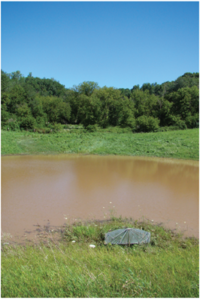
A GSS (figure 1) is a relatively inexpensive, yet highly effective, conservation tool for improving water quality in highly erosive landscapes. The purpose of a GSS is to reduce water’s velocity as it runs off the land, preventing excessive amounts of sediment and nutrients from entering waterways. It is not designed to remove dissolved N and P out of solution; instead, it physically stops sediment and sediment bound (particulate) components from continuing downslope.
In general, a GSS requires minimal land disturbance and little maintenance. The structure consists of a large embankment, usually placed on a hillside, that retains storm runoff long enough to allow transported sediments to settle out of the runoff (figure 1). Unlike retention ponds and sediment basins, which are commonly used in construction and mining industries, GSSs allow for the infiltration of retained water. A thick metal pipe and an animal guard are often placed below the embankment’s height to prevent overflowing (figure 2).
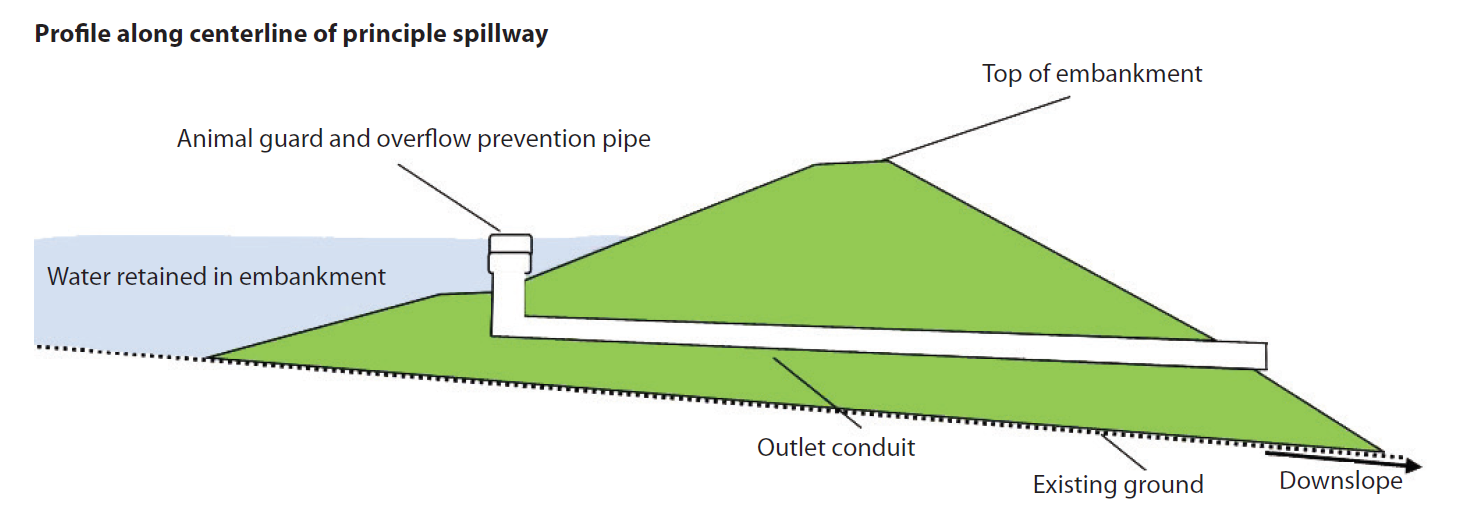
When installing a GSS, follow the Natural Resources Conservation Service standard for these structures (Code 410); the standard applies to all types of grade stabilization structures, including earth embankments, mechanical spillways, and detention structures. The lifespan of a GSS is at least 15 years (Patrick Murphy, personal communication, 2014), but the cost can vary widely depending on area and site. For example, installing on ridge sites can cost $4,000– $5,000, and installing on valley sites can cost $6,000–$8,000, depending on the drainage area. Some installations can cost up to $25,000 (Tom Schultz, personal communication, 2015).
Where a GSS fits on farms
A GSS is designed to slow down and retain surface runoff originating from flat-top ridges and steep side slopes, so farms with such landscape features may want to consider a GSS. Ideal GSS locations are within current or proposed grass waterways or sloped areas prone to erosion. Since the purpose of a GSS is to prevent erosion and slow water’s velocity, it’s sensible to locate it in a place where those issues are of greatest concern.
GSS research
Research conducted by UW Discovery Farms® program, in partnership with the U.S. Geological Survey’s Wisconsin Water Science Center, offers tangible evidence on the ability of a GSS to reduce sediment and nutrient loss. Data were collected as part of an eight-year study on a Buffalo County farm located in the Driftless Region of southwest Wisconsin.

The region’s topographic characteristics make it ideal for using a GSS: Flat-top ridges, steep side slopes, and narrow valleys overlying dolostone bedrock make this landscape highly susceptible to runoff. Nutrient transport is a very real concern in this region. Adopting conservation practices can reduce the total amount of erosion and runoff substantially, but more improvements could enhance the overall health of waterways.
In-stream monitoring stations were installed within two adjacent watersheds (North Watershed and South Watershed) on the selected farm (figure 3). The North Watershed is 430 acres and has 172 acres (40%) of cropland and pasture and 258 acres (60%) of woodland and grassland. Farmed slope grades range from 16% to 32%. The South Watershed is 214 acres with only 38 acres (18%) of cropland and pasture and 176 acres (82%) of woodland and grassland. Slopes have an average grade of 25% in both watersheds.
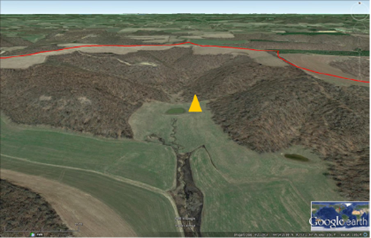
The GSS was installed at the base of a forested hillside in the North Watershed, bisecting the drainage flow path of the valley (figure 4). The landowner recognized it as a place where a substantial amount of soil was eroding from the ridge-top fields and forested hill slopes.
This study compared runoff volumes, sediment concentrations, and P and N concentrations between the two watersheds pre- and post-installation of a GSS in the North Watershed (figure 4). Particle size analysis was also conducted on soil samples from inside and outside the GSS to determine if sediments were retained in the structure.
Sediment
GSS installation reduced the average sediment concentrations that were deposited in nearby waterways by 73% (table 1). After installing the GSS, sediment concentrations in runoff in the North Watershed, which was more influenced by agricultural activities, were reduced to levels similar to those of the South Watershed, which had less agricultural activity.

To further validate the ability of a GSS to retain sediment, eight soil cores were taken immediately uphill from the embankment and within the area where the structure retains water, and nine soil cores were taken outside of it. Samples within the GSS had clay concentrations greater than samples from outside the structure (table 2), indicating that clay particles were transported with surface runoff, were captured, and then settled out at the soil surface within the GSS.

Both total phosphorus (TP) and total nitrogen (TN) were reduced after installation of a GSS, but the dissolved components of P and N were unaffected. Average event TP concentration was reduced by 62% and average event TN concentration was reduced by 51% (table 3). Since there was no change in TP in the South Watershed, it is clear that the installation of the GSS caused the TP to decrease. Interestingly, TP concentrations in the North Watershed, which was more influenced by agricultural activities, were reduced to levels similar to those in the South Watershed. The North Watershed’s decrease in TN concentrations after the GSS installation occurred simultaneously with the South Watershed’s increase in Tn concentrations, which further highlights the structure’s effect.
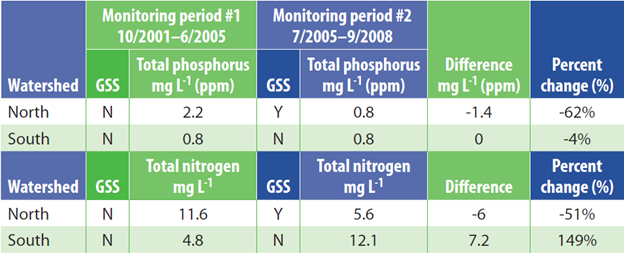
TP consists of particulate phosphorus (PP) and dissolved phosphorus (DP). The PP represents phosphorus attached to sediment particles, while the DP represents phosphorus that is in a solution and is highly bioavailable for aquatic organisms. DP concentrations were relatively low in both watersheds during both time periods (0.3–0.6 mg L-1), and no change in DP concentrations was detected after installation. The reduction in TP was driven exclusively by a reduction in PP, caused by the reduction in sediment loss.
The TN concentration in water is comprised of organic N (in particulate and dissolved form) and dissolved inorganic N (as ammonium and nitrate). Ammonium and nitrate concentrations were analyzed separately, and no reductions were observed after GSS installation. Nitrate concentrations were typically below 3 mg L-1, and ammonium concentrations were typically below 0.1 mg L-1 for any storm event, so the TN decrease likely resulted from a reduction in organic nitrogen, which exists primarily as particulate N. These results are also consistent with the observed reduction in sediment following GSS installation. It is unsurprising that the structure would not reduce dissolved nutrient loads since it is designed to settle out particulates, rather than filter out or retain dissolved nutrients.
Conclusion
A GSS can be a very effective on-farm conservation tool. A GSS installed in the Driftless Region was found to meaningfully reduce sediment concentrations by 73% and total P concentrations by 62%. In addition, total nitrogen concentrations were reduced by 51%. The reduction in total P and total N concentrations resulted primarily from a reduction in the P and N associated with the sediment in runoff (i.e., particulate P and N). No significant reductions in dissolved P or N were observed. Installation of multiple GSSs within the agricultural watersheds of the Driftless Region and other areas with similar landscapes could profoundly impact water quality of these areas. These structures should be built across gullies or grass waterways to slow water’s velocity and allow water to either infiltrate or exit through a pipe at a lower elevation, thereby protecting the soil from gully erosion and scouring. In areas where installation is appropriate, a GSS is recommended in addition to other conservation practices to reduce the sediment and nutrient concentrations entering waterways.
Overall, installing a GSS as a conservation practice has many benefits:
- reduces the amount of sediment being transported to surface waters
- reduces particulate phosphorus concentrations in runoff
- reduces organic N concentrations in runoff, mostly in the form of particulate bound N
- requires little land disturbance and little maintenance
- is not overly expensive
References
Conservation Practice Standard: Grade stabilization structure. Code 410. Natural Resources Conservation Service, September 2014:
www.nrcs.usda.gov/Internet/FSE_ DOCUMENTS/stelprdb1263175.pdf.
Minks, K.R., Lowery, B. Madison, F.W., Ruark, M.D., Frame, D., Stuntebeck, T. & Komiskey, M. 2012. An at-grade stabilization structure impact on runoff and suspended sediment. Journal of Soil and Water Conservation, 67 (4), 237-247.
Minks, K., Ruark, M., Lowery, B., Madison, F., Frame, D., Stuntebeck, T., Komiskey, M., Kraft, G. 2015. At-grade stabilization structure impact on surface water quality of an agricultural watershed. Journal of Environmental Management 50(9), 153. www.ncbi.nlm.nih.gov/pubmed/25657061
Murphy, Patrick, USDA-NRCS. Personal communication, 2014.
Schultz, Tom, Buffalo County Land Conservation Department. Personal communication, 2015.
USDA NRCS. 2005. Construction plan for BMP# 830 grade stabilization structure (410). Wisconsin Standard Drawing no. WI-001.
USEPA. 2010. Watershed assessment, tracking & environmental results: National Summary of State information. Available at iaspub.epa.gov/waters10/ attains_nation_cy.control.
Authors: Callie L. Herron, Outreach Specialist, Discovery Farms; Matthew D. Ruark, Extension Specialist at UW-Extension and Assistant Professor at UW–Madison; and Kyle R. Minks, Conservation/Nutrient Specialist, Dane County Land and Water Resources Department. Acknowledgments: The authors would like to thank the Bragger Family for allowing the research to be conducted on their farm, the USGS, and WGNHS. Cooperative Extension publications are subject to peer review.
For more information on the Bragger Family Dairy, a Discovery Farms Core Farm, visit uwdiscoveryfarms.org.
Conservation Benefits of a Grade Stabilization Structure (A4099) I-08-2015

 Save money and get cleaner water by correctly utilizing manure
Save money and get cleaner water by correctly utilizing manure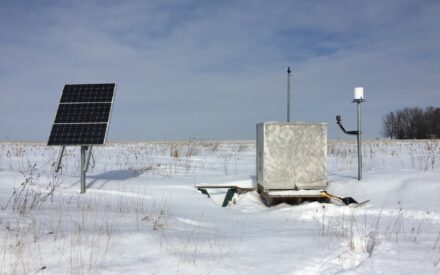 Discovery Farms- Rock County Monitoring Report
Discovery Farms- Rock County Monitoring Report Field Notes Episode 8: Ag, Water, and Processing Vegetables
Field Notes Episode 8: Ag, Water, and Processing Vegetables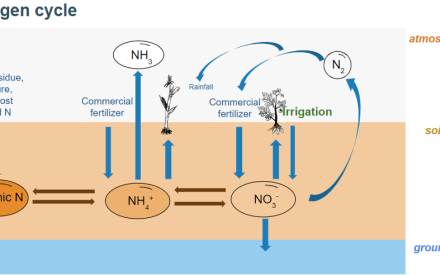 How much nitrogen is in your irrigation water?
How much nitrogen is in your irrigation water?


